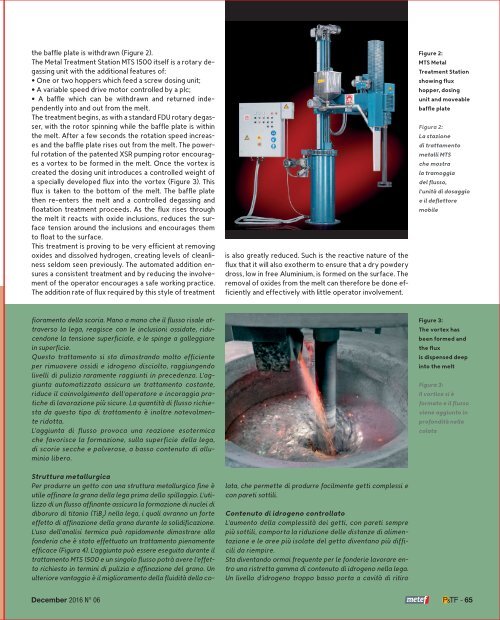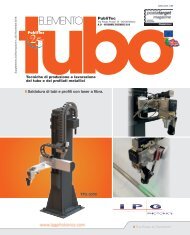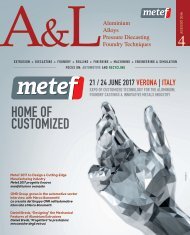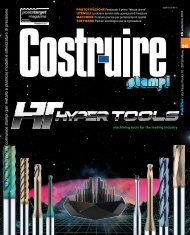sfogliabile_AL_n6_dicembre
Create successful ePaper yourself
Turn your PDF publications into a flip-book with our unique Google optimized e-Paper software.
thebaffleplateiswithdrawn(Figure2).<br />
The Metal Treatment Station MTS 1500 itself is a rotary degassing<br />
unit with the additional features of:<br />
• One or two hoppers which feed a screw dosing unit;<br />
• Avariablespeeddrivemotorcontrolledbyaplc;<br />
• A baffle which can be withdrawn and returned independently<br />
into and out from the melt.<br />
The treatment begins, as with a standard FDU rotary degasser,<br />
with the rotor spinning while the baffle plate is within<br />
the melt. After a few seconds the rotation speed increasesandthebaffleplaterisesoutfromthemelt.ThepowerfulrotationofthepatentedXSRpumpingrotorencourages<br />
a vortex to be formed in the melt. Once the vortex is<br />
created the dosing unit introduces a controlled weight of<br />
aspeciallydevelopedfluxintothevortex(Figure3).This<br />
fluxistakentothebottomofthemelt.Thebaffleplate<br />
then re-enters the melt and a controlled degassing and<br />
floatation treatment proceeds. As the flux rises through<br />
the melt it reacts with oxide inclusions, reduces the surface<br />
tension around the inclusions and encourages them<br />
to float to the surface.<br />
This treatment is proving to be very efficient at removing<br />
oxides and dissolved hydrogen, creating levels of cleanliness<br />
seldom seen previously. The automated addition ensuresaconsistenttreatmentandbyreducingtheinvolvement<br />
of the operator encourages a safe working practice.<br />
Theadditionrateoffluxrequiredbythisstyleoftreatment<br />
isalsogreatlyreduced.Suchisthereactivenatureofthe<br />
fluxthatitwillalsoexothermtoensurethatadrypowdery<br />
dross,lowinfreeAluminium,isformedonthesurface.The<br />
removalofoxidesfromthemeltcanthereforebedoneefficiently<br />
and effectively with little operator involvement.<br />
Figure 2:<br />
MTS Metal<br />
Treatment Station<br />
showing flux<br />
hopper, dosing<br />
unit and moveable<br />
baffle plate<br />
Figura 2:<br />
La stazione<br />
di trattamento<br />
metalli MTS<br />
che mostra<br />
la tramoggia<br />
del flusso,<br />
l’unità di dosaggio<br />
eildeflettore<br />
mobile<br />
fioramento della scoria. Mano a mano che il flusso risale attraverso<br />
la lega, reagisce con le inclusioni ossidate, riducendonelatensionesuperficiale,elespingeagalleggiare<br />
in superficie.<br />
Questo trattamento si sta dimostrando molto efficiente<br />
perrimuovereossidieidrogenodisciolto,raggiungendo<br />
livelli di pulizia raramente raggiunti in precedenza. L’aggiunta<br />
automatizzata assicura un trattamento costante,<br />
riduceilcoinvolgimentodell’operatoreeincoraggiapratiche<br />
di lavorazione più sicure. La quantità di flusso richiestadaquestotipoditrattamentoèinoltrenotevolmente<br />
ridotta.<br />
L’aggiunta di flusso provoca una reazione esotermica<br />
che favorisce la formazione, sulla superficie della lega,<br />
discorieseccheepolverose,abassocontenutodialluminio<br />
libero.<br />
Figure 3:<br />
The vortex has<br />
been formed and<br />
the flux<br />
is dispensed deep<br />
into the melt<br />
Figura 3:<br />
Il vortice si è<br />
formato e il flusso<br />
viene aggiunto in<br />
profondità nella<br />
colata<br />
Struttura metallurgica<br />
Perprodurreungettoconunastrutturametallurgicafineè<br />
utile affinare la grana della lega prima dello spillaggio. L’utilizzodiunflussoaffinanteassicuralaformazionedinucleidi<br />
diboruro di titanio (TiB 2<br />
)nellalega,iqualiavrannounforte<br />
effetto di affinazione della grana durante la solidificazione.<br />
L’uso dell’analisi termica può rapidamente dimostrare alla<br />
fonderia che è stato effettuato un trattamento pienamente<br />
efficace(Figura4).L’aggiuntapuòessereeseguitaduranteil<br />
trattamento MTS 1500 e un singolo flusso potrà avere l’effettorichiestointerminidipuliziaeaffinazionedelgrano.Un<br />
ulteriorevantaggioèilmiglioramentodellafluiditàdellacolata,<br />
che permette di produrre facilmente getti complessi e<br />
con pareti sottili.<br />
Contenuto di idrogeno controllato<br />
L’aumento della complessità dei getti, con pareti sempre<br />
più sottili, comporta la riduzione delle distanze di alimentazioneeleareepiùisolatedelgettodiventanopiùdifficili<br />
da riempire.<br />
Sta diventando ormai frequente per le fonderie lavorare entrounaristrettagammadicontenutodiidrogenonellalega.<br />
Un livello d’idrogeno troppo basso porta a cavità di ritiro<br />
December 2016 N° 06<br />
- 65





